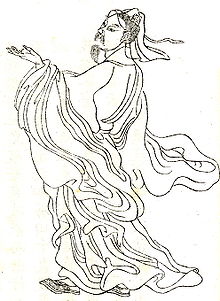Gu Kaizhi

Gu Kaizhi (simplified Chinese: 顾恺之; traditional Chinese: 顧愷之; pinyin: Gù Kǎizhī; Wade–Giles: Ku K'ai-chih; c. 344–406), courtesy name Changkang (長康), was a Chinese painter and politician. He was a celebrated painter of ancient China.[1] He was born in Wuxi and first painted at Nanjing in 364. In 366, he became an officer (Da Sima Canjun or Assistant to the Minister of Defense, 大司馬參軍). Later he was promoted to royal officer (Sanji Changshi or Gentleman in Waiting to the Emperor, 散騎常侍). He was also a talented poet and calligrapher. He wrote three books about painting theory: On Painting (畫論), Introduction of Famous Paintings of Wei and Jin Dynasties (魏晉勝流畫贊) and Painting Yuntai Mountain (畫雲台山記). He wrote: "In figure paintings the clothes and the appearances were not very important. The eyes were the spirit and the decisive factor."[1]
Gu's art is known today through copies of several silk handscroll paintings attributed to him.
Biography
Gu Kaizhi was born in Wuxi (in modern Jiangsu) where his father served in the imperial secretariat as an assistant. At about nineteen he was employed as aide to the Grand Marshal Huan Wen. He held an succession of minor official posts under various leaders of the Eastern Jin court.[2]
One emperor under whom Gu Kaizhi served was Huan Xuan. An enthusiastic art collector, ahead of his accession Huan Xuan ordered a big boat to store paintings and other treasures so that they could be easily transported to safety in case of war. Gu Kaizhi entrusted to the emperor a sealed chest with his most precious works. The emperor broke open the box, stole the paintings, then repaired and returned it to the artist with the seals intact. Upon discovering his loss, Gu Kaizhi said that "the marvelous works partook of divine power, transformed themselves and vanished, like men ascending to join the immortals."[2]
Works
The Admonitions of the Instructress to the Court Ladies (女史箴圖)
This painting, dated between the 6th and 8th century AD
The painting is on silk and is a polychrome. "The figures, whose countenances are at once solemn and tranquil, are described with a thin, unmodulated brush-line.... The brush-mode...has been described as 'spring silkworms spitting silk'".[5]
Nymph of the Luo River (洛神賦)
Nymph of the Luo River is a painting by Gu which illustrates a poem written by
Wise and Benevolent Women (列女仁智圖)
Wise and Benevolent Women survives in a 13th-century copy dating to the Song dynasty, and is today located in the Palace Museum in Beijing.[7] It illustrates a subset of the women described in the Han dynasty work Biographies of Exemplary Women. The 5-meter-long scroll is divided into 10 sections, with each section containing a short description.[8]
Notes
- ^ a b c Cihai: Page 1846.
- ^ a b Sullivan (1962). The Birth of Landscape Painting in China. University of California Press. p. 90. GGKEY:APYE9RBQ0TH.
- ^ Admonitions Scroll
- ^ "Gu Kaizhi | Tang Dynasty, Calligraphy, Poetry | Britannica". www.britannica.com. Retrieved 2023-11-23.
- ISBN 4-544-02066-2, p. 129
- ^ a b c d "Nymph of the Luo River". Archived from the original on 2012-03-15. Retrieved 2011-05-13.
- ISBN 0-226-36074-1.
- ^ (Xin et al. 1997, p. 47)
References
- Xin, Yang; Chongzheng, Nie; Shaojun, Lang; Barnhard, Richard M (1997), Three thousand years of Chinese painting, New Haven, ISBN 978-0-300-07013-2
- Ci hai bian ji wei yuan hui (辞海编辑委员会). Ci hai (辞海). Shanghai: Shanghai ci shu chu ban she (上海辞书出版社), 1979.
Further reading
- McCausland, Shane; Museum, British (2003), Gu Kaizhi and the Admonitions scroll, British Museum Press






